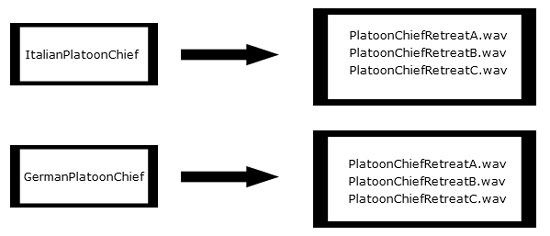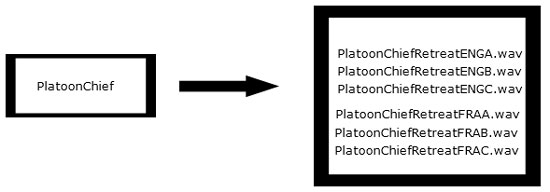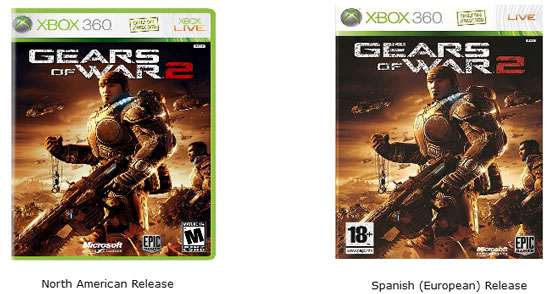Stay Up To Date With Us!
We will never spam you or share your email address.
Game Sound Design Strategies
GSD StrategiesCheck out the gamesounddesign.com strategies when you are feeling creatively uninspired. Each random strategy will present you with a new avenue to pursue. Give them a try!
Game Sound Design Glossary
GSD GlossaryOur game audio glossary has all the sound terms you have been wondering about. Game audio can be confusing enough without having to deal with a new technical language. We are constantly updating the database with new terms that relate to not only game audio but game developer terms as well.
Video Game Localization - More Important Than You Thought
Article by George Spanos
Video game localization is the process whereby a game's primary language is translated into other languages in order to accommodate foreign speaking gamers. Many video game publishers require their titles to be localized for a host of major markets. Localization is a very big deal to publishers and the bottom line considering that sometimes up to 50% of a AAA title's sales can be outside of North America.
Another important facet of properly localized audio is to consider the linguistic differences of each region that the game is to be sold in. For example, quite often there will be a so called "North American Spanish" SKU (Stock Keeping Unit, also known as the specific packaged localized copy of the game on disc) as well as a "Spanish" SKU that will be sold mainly in Spanish speaking countries outside of North America such as Spain.
Additionally, games will sometimes have a few localized versions on one disc. In Canada for example, you'll find the English as well as French versions of the game on one disc.
In the United States quite often English as well as North American Spanish will be on one disc. Generally though, English will be supplied on every foreign version of the game (assuming it is a North American title).

One popular term that has come to be known simply by its shortened form is EFIGS. EFIGS is an acronym for English French Italian German Spanish. Most games that are to be localized will be localized in these languages first and foremost. Occasionally Chinese and Japanese (as well as sub-variations of these languages like Mandarin) will also be included but generally these five languages are the most common.
First Steps
When a publisher has decided upon creating a localized version of the game you are working on, it may be up to you, the sound designer to provide the necessary information to the localization department. It is very important to make sure that you are providing the team responsible for recording the language versions all of the pertinent information such as takes, timings, and format.
A good starting point is to make sure that when the English voices are recorded that there is a spreadsheet or some other form of tracking document that will break each line down into an easily readable chunk. Each line of dialogue should have an associated filename and tag that can be easily searched for and indexed. The final timing of each line should also be listed in this master file so that localization can get a clear picture of what timings they need to aim for.
Because re-recording actors can be time consuming and can cost a lot of money, you should try to get it right the first time. Quite often though, a pickup session will be accounted for because of other unforeseen situations that may arise. Situations, where for whatever reason, words from a sentence have been cut or more drastically whole lines and paragraphs are re-written. This is a common occurrence in game development as it is in most other sound related industries. Indeed, localized audio is quite often left to the very end of a production's development cycle because publishers want to make sure that final English timings have been nailed down and all the required English lines have been recorded. There are ways to minimize the last minute scramble however, and I will outline them below.
Lines and Timings
As mentioned in the previous paragraph it is essential that a master list is created with line numbers and timings. Another very helpful resource to provide to the localization team are references. Providing audio references of the lines to be localized will not only help for timing but also for intonation and intent. The idea of localization is to try to match, as closely as possible, the original English recordings. As the localization actors are provided with a backstory on the character they are reading for they should also be provided with audio samples to listen to. If possible all the English audio files should be provided so that mimicry comes as close as possible for each language.
This next part cannot be stressed enough: TIMING. Proper timing of recorded lines that are to be localized is mandatory. You do not want to find yourself in the position of receiving the final localized lines at the eleventh hour of a project to only find out that they are too long or too short. Localization should aim to provide the sound design (or other implementing) team with lines in each language that match the English timings as close as possible. My recommendation is to be within +/- 0.5 seconds for your average sentence; closer if possible.
This is especially true in cinematics where there is a definite flow and pacing to the movie. Having the localized versions come as close as possible to the timings of each character's lines in a cinematic will yield a more convincing listening experience for your foreign listeners and will also ensure that the lines will not overlap or extend past the duration of the cinematic.
File Formats and Naming Conventions
The next step is to determine what format you would like to receive the localized versions of the audio. This is largely dependent on what file format specifications the game engine you are working with is expecting. Generally, receiving the localized files in the same file format, bit depth, and sample rate of all other audio in the game is advisable. After all, you can always manually batch convert files into other lower sample rates if need be.
In your localization spreadsheet also set up naming conventions that you want the localization team to follow. A good way of approaching this is to name the files the same in each language (and place them in separate language folders) so that it is easier to find them later, or append the localized short form of the language at the end of each filename. Example:

In the above example, we have three variations of the Platoon Chief in our game yelling Retreat! to his squad, placed inside of the English Platoon Chief folder. For the localized versions we could lay out the folders and file naming in this way:

Another way to lay out your folder hierarchy would be to append the language code on the end of the filename for example:

In this last example all files are placed within one master folder entitled PlatoonChief. Then all files within the master folder are appended with their language short form code. ENG=English, FRA=Francais, ITA=Italiano, etc.
It is important to mention at this point that all localized languages should contain the same number of variations of each line that the English incorporates; you want to provide your foreign gamers with the same amount of variety that the English SKU incorporates!
Sound Effects, Music, and Post Processing
If your localized audio requires that certain sound effects and music be incorporated into the localized file, then be sure to provide the localization team with this information. Provide the English version of the file to be copied as well as all the sound effects and music (if required) so that they may mix these elements into the files for you; you don't want to have to rely on Google translate to find the right times to place your sound effects and music into the files.
Another important consideration is any post processing that was done to the English versions of the files. If certain equalization, reverbs, or other signal processing was incorporated then providing clear instructions on the exact process that was used is an absolute must. You do, after all, want the localization to sound as close as possible to the way you intended the English versions to sound. Because you will probably be receiving localized files at the end of the project during crunch time, the last thing you want is to have to post process all the localized language versions, which can be very time consuming even with batch processing techniques.
Latest Version and Quality Assurance
As mentioned earlier quite often the dialogue in a game will change quite dramatically through the production phase. It is important to keep up to date notes in your spreadsheet of all edits and re-records of the English files. Always update the localization team with the most current edits so that they may be able to act quickly and translate the edited versions. You don't want to have to hunt for other members on the development team who can speak French, Italian, German, and Spanish to help you edit the files (though this is not unheard of)!
Lastly, do not under estimate the power of the Quality Assurance (QA) team. They are on the project to help you find language bugs in addition to finding other non-audio related issues. Quite often there will be specific language QA teams that will check the game to make sure that all languages have been implemented and translated correctly. Make doubly sure that they PLAY THROUGH THE GAME and not just rely on cheats that may have been provided to quickly check localization. There is no substitute for playing through the game in its entirety to make sure that there is no English audio leaking into the French version, for example. If problems are found (like non translated lines) then be sure to bring them to the localization teams' attention as soon as possible so that the issues may be corrected.

Two versions of the popular Gears of War 2 game. The one on the left is the North American release while the one on the right is the Spanish (European) release. Both look very near to identical except the European release has a region code of "PAL" in the top right while the North American version has a region code of "NTSC". Region codes refer to the differences in television displays for North America (60 Hz) and Europe (50 Hz).
In Conclusion
Localization is a multi faceted requirement that should not be taken lightly. Given the fact that there are billions of people in the world who do not speak English, it only makes sense from a publisher's perspective to translate the game into as many languages as possible. This will help to sell the game in markets and territories that were previously unavailable and will help to give your game the notoriety and sales it deserves after all the hard work you and your team have put into it.

